Is Apple Being Honest About ShotOniPhone Videos?
Apple launched their first ShotOniPhone campaign to coincide with the release of the iPhone 6 back in 2014. The campaign was a huge success, celebrating the ordinary people behind the camera who were achieving great results. Although this is only just over 5 years ago, it feels like a lot has happened since.
In 2015, shot on iPhone 5s feature film Tangerine made a splash at Sundance. Last year, Steven Soderbergh made 2 feature films with iPhone 7+ and iPhone 8+. Smartphone cameras (not just iPhones) have made huge leaps forward, along with a long list of accessories for filmmaking.
Snowbrawl
Recently, a lot of online excitement was generated when John Wick and Deadpool 2 director John Leicht teamed up with Apple for the latest “Shot on iPhone” ad. Of course, Leicht used the new iPhone 11 Pro.
It’s undoubtedly a brilliant little film, excellently shot and edited to create an pacey action scene. But it’s certainly a long way from the original concept driving the Shot on iPhone ideal.
Back in 2014, the message was “anyone can now shoot amazing photos with their smartphone”. But this message is a little different. Anyone can shoot an action movie on their iPhone… as long as you have a top director, a large profesional crew, plenty of extra equipment and a few thousand dollars worth of post-production.
And plenty of people are insistent this is a deceptive tactic. One reason why Apple switch the comments off these Shot on iPhone videos, possibly. But reading comments elsewhere there are a few along the lines of this one: “it’s technically correct that the video was shot on an iPhone. But the video is trying to sell you on the notion that you too could shoot such videos, which is BS unless you have a lot of equipment, expertise, and help that no normal person will have.” left by a CultOfMac reader.
Crew, Effects, Grading
The question is, is it OK to use extra skills, crew, post-production work and so on? Is this still smartphone filmmaking? For our festival, we don’t care what you do to the footage or how you shoot it, as long as it’s shot on a mobile device.
I’m working on post production of a short shot on a Samsung S9 at the moment. I’m doing a lot of extra work, including adding some fake shallow depth of field by hand masking subjects. Is this cheating?
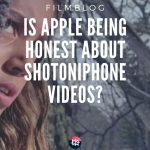 Thing is, when I was doing post production on a previous SciFi show, which was shot on a Black Magic camera, I did exactly the same. I spent just as long (if not longer) grading, masking, adding VFX and so on. It’s really just a major part of digital filmmaking in general.
Thing is, when I was doing post production on a previous SciFi show, which was shot on a Black Magic camera, I did exactly the same. I spent just as long (if not longer) grading, masking, adding VFX and so on. It’s really just a major part of digital filmmaking in general.
So perhaps the problem is the Shot on iPhone campaign began as a “anyone can do this” message. Which makes more sense for photography. But for filmmaking (although I still say anyone can make a movie with their smartphone), it’s not quite the same.
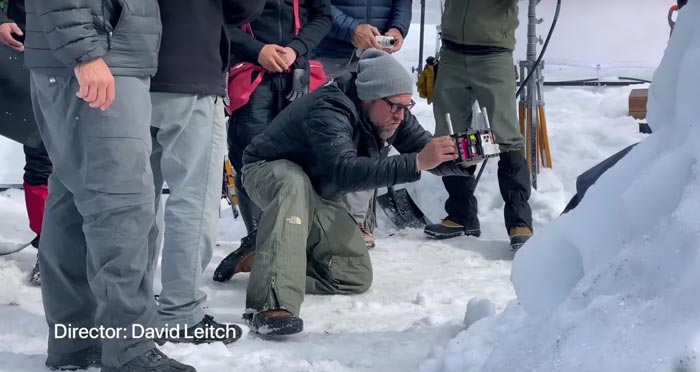
Can any of us do this?
What’s cool is there’s also a making of companion video, so we ca get some clues as to what they had to work with.
In that image above, you can see Leicht holding the iPhone 11 Pro mounted in what looks like a Beastgrip. So that’s something most of us can afford (I bought the Zecti low cost copy version).
What’s this?
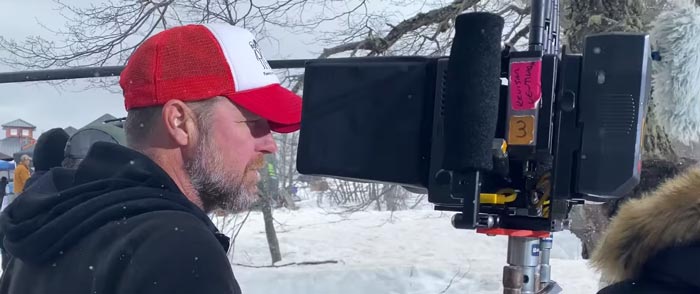
Something mounted to a stand. I don’t know, some kind of panel light? But I’m guessing I can’t afford this (or the transport to get it to location).
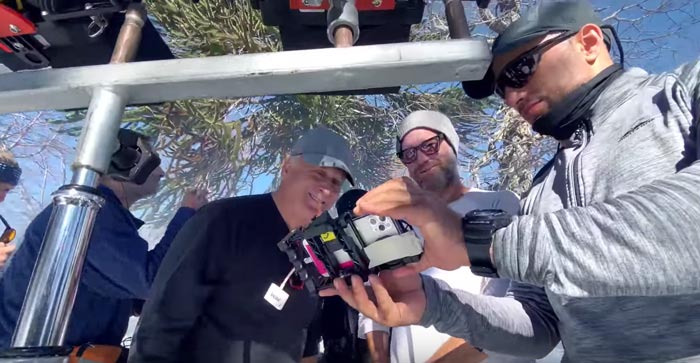
Some more lights on big stands…. Plenty of crew…
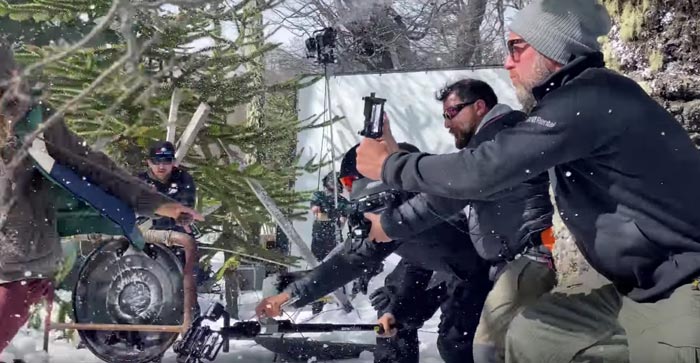
Anyone who says they don’t need a gimbal now as their phone has great inbuilt stabilization, check this out. There’s a guy with the iPhone 11 Pro in a Beastgrip again. But there’s also another guy with an iPhone on smartphone gimbal attached to an extension pole (see bottom of the image). This way he can get a great moving angle very easily. Imagine doing that with a bigger camera?
Not sure what the guy in the middle is holding. Is that a light? Oh and they have a big white screen and a snow machine on a tall pole.
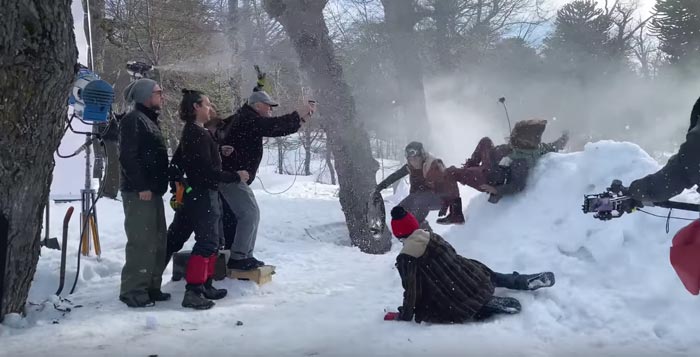
Here we can see what that big white screen is for. To reflect back the light from the blue Arri lamp mounted on the stand (left). Again, there’s the guy with the iPhone on a gimbal with pole extension (right). See how this creates a cheap and easy to use jib arm?
And look, Leicht is just hand-holding his iPhone like the rest of us.
“We’re getting creative with the flexibility of the camera. How light they are. How mobile they are.” David Leicht.
That’s what we like to see, right?
One thing that bugs me is when they do these videos and don’t exploit the advantages of the smartphone. In this case, they’ve really embraced it and that’s very cool to see.
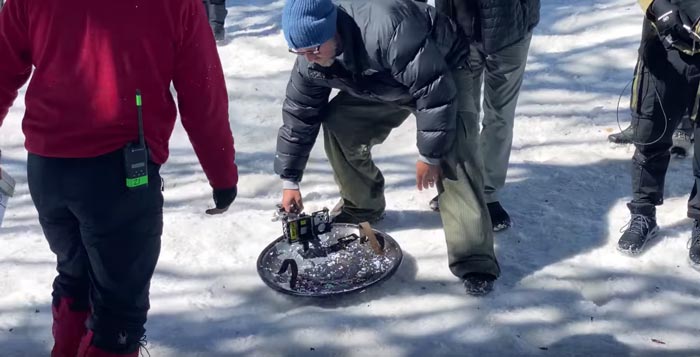
Here we see the iPhone attached to a shield, which is then spun across the ice. Because the iPhone is so light, this shot is much more doable than with a heavier camera.
So yes, of of course Leicht has a ton more kit and crew than is available to most of us. However, he has approached it with the right attitude, in my opinion. And we can always see how they did things and get inspiration for our own films.
It’s true that they had access to a ton of stuff we don’t but at least they’re honest about it. The behind the scenes video shows you exactly what they had to shoot this video (minus the post work). As a smartphone filmmaker myself, I got some great tips and ideas there for my own work.
Eager to learn more?
Join our weekly newsletter featuring inspiring stories, no-budget filmmaking tips and comprehensive equipment reviews to help you turn your film projects into reality!
Simon Horrocks
Simon Horrocks is a screenwriter & filmmaker. His debut feature THIRD CONTACT was shot on a consumer camcorder and premiered at the BFI IMAX in 2013. His shot-on-smartphones sci-fi series SILENT EYE featured on Amazon Prime. He now runs a popular Patreon page which offers online courses for beginners, customised tips and more: www.patreon.com/SilentEye


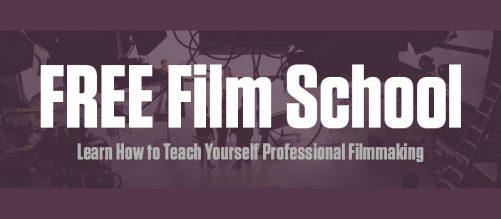
Your comment on adding shallow depth of field to a film shot on a blackmagic camera is really not a fare comparison. Because needing to create depth of field for the Blackmagic shoot would be completely the fault of the cinematographer, not the camera. Whereas with a phone, it’s going to be a must.
None of the shorts I’ve shot, have had the need to spend hours fixing depth of field.
Again, starting off with unnecessary limitations, considering how cheap you can get some really great used gear for is just not worth it, IMO.
Thats not a light panel thats a video village lmao